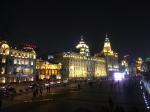Shanghai (China)
Located in the Yangtze River Delta in East China,
Shanghai sits at the mouth of the Yangtze River in the middle portion of the Chinese coast. For centuries a major administrative, shipping, and trading town, Shanghai grew in importance in the 19th century due to European recognition of its favorable port location and economic potential. The city was one of several opened to foreign trade following the British victory over China in the First Opium War and the subsequent 1842 Treaty of Nanking which allowed the establishment of the Shanghai International Settlement. The city then flourished as a center of commerce between east and west, and became the undisputed financial hub of the Asia Pacific in the 1930s. However, with the Communist Party takeover of the mainland in 1949, trade was reoriented to focus on socialist countries, and the city's global influence declined. In the 1990s, the economic reforms introduced by Deng Xiaoping resulted in an intense re-development of the city, aiding the return of finance and foreign investment to the city.
The twenty closest neighbours in the database:
Hangzhou (China) (163 km),
Nanjing (China) (275 km),
Beijing (China) (1,072 km),
Kyoto (Japan) (1,393 km),
Tokyo (Japan) (1,757 km),
Halong Bay (1,828 km),
Hanoi (Vietnam) (1,925 km),
Hue (Vietnam) (2,161 km),
Hoi An (Vietnam) (2,164 km),
Temples of My Son (2,188 km),
Temple of Banteay Srei (2,653 km),
East Mebon Temple (2,669 km),
Temple of Neak Pean (2,669 km),
Temple of Preah Kahn (2,671 km),
Temple of Banteay Kdei (2,672 km),
Temple of Ta Prohm (2,672 km),
Angkor Thom (2,674 km),
Temple of Bakong (2,675 km),
Angkor Wat (2,675 km),
Ho Chi Minh City (Vietnam) (2,739 km)
Take a birds-eye view of the current location:
Google Maps,
OpenStreetMap,
Bing Maps,
Yahoo!Maps




































































































































































































































































































































































































